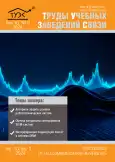Интерференция между поднесущими частотами в системе DRM
- Авторы: Ковалгин Ю.А.1
-
Учреждения:
- Санкт-Петербургский государственный университет телекоммуникаций им. проф. М. А. Бонч-Бруевича
- Выпуск: Том 10, № 3 (2024)
- Страницы: 35-44
- Раздел: ЭЛЕКТРОНИКА, ФОТОНИКА, ПРИБОРОСТРОЕНИЕ И СВЯЗЬ
- URL: https://journals.rcsi.science/1813-324X/article/view/259510
- EDN: https://elibrary.ru/MDQDUX
- ID: 259510
Цитировать
Полный текст
Аннотация
Об авторах
Ю. А. Ковалгин
Санкт-Петербургский государственный университет телекоммуникаций им. проф. М. А. Бонч-Бруевича
Email: kowalgin@sut.ru
ORCID iD: 0000-0002-6753-8062
SPIN-код: 4476-0420
Список литературы
- Бакулин М.Г., Крейнделин В.Б., Шлома А.М., Шумов А.П. Технология OFDM: учебное пособие для вузов. М.: Горячая линия – Телеком, 2016. 352 с. EDN:YPURRV
- Cho Y.S., Kim J., Yang W.Y., Kang C.G. Mimo-OFDM Wireleess Communications with Matlab. Singapore: John Wiley & Sons, 2010. 544 p.
- Fazel K., Kaiser S. Multi-Carrier and Spread Spectrum Systems: from OFDM and MC-CDMA to LTE and WiMAX. John Wiley & Sons, 2008. 384 p.
- Kung T.L. Synchronization and Coding in Wireless Communications Systems. Dissertation Submitted to the Faculty of the Graduate School of the University of Minnesota. 2013. p. 156.
- Younis S.B.T. Synchronization Algorithms and Architectures for Wireless OFDM Systems. PhD Thesis. Newcastle University, 2012. 197 p. URL: http://hdl.handle.net/10443/1417 (Accessed 20.04.2024)
- Батырев А.И. Оценка влияния сдвига несущей частоты на качество принимаемого сигнала // Омский научный вестник. 2015. № 3(143). С. 259‒262. EDN:VCNUSF
- Speth M., Fechtel S.A., Fock G., Meyr H. Optimum Receiver Design for Wireless Broad-Band Systems Using OFDM. Part I // IEEE Transactions on Communications. 1999. Vol. 47. Iss. 11. PP. 1668–1677. doi: 10.1109/26.803501
- Morelli M., Kuo C.C.J., Pun M.O. Synchronization Techniques for Orthogonal Frequency Division Multiple Access (OFDMA): A Tutorial Review // Proceedings of the IEEE. 2007. Vol. 95. Iss. 7. PP. 1394‒1427. doi: 10.1109/JPROC.2007.897979
- Sun Z., Peng T., Wan W. A novel sampling synchronization scheme for OFDM-based system with unified reference clock // Journal on Wireless Communications and Networking. 2012. Vol. 2012. P. 368. doi: 10.1186/1687-1499-2012-368
- Zhao Y., Häggman S.-G. Intercarrier Interference Self-Cancellation Scheme for OFDM Mobile Communication Systems // IEEE Transactions on Communications. 2001. Vol. 49. Iss. 7. PP. 1185‒1191. doi: 10.1109/26.935159
- Raboh M.S.A., Al Bassiouni A.A.M., Zakaria H.M., El Bahy M.M. Performance Analysis of OFDM Systems Subjected to Carrier Frequency Offset in Fading Communication Channels // International Journal of Engineering Research & Technology. 2015. Vol. 4. Iss. 7. URL: https://www.ijert.org/research/performance-analysis-of-ofdm-systems-subjected-to-carrier-frequency-offset-in-fading-communication-channels-IJERTV4IS070404.pdf (Accessed 20.04.2024)
- Жерносеков Р.А., Першин В.Т. Синхронизация системы мультиплексирования с ортогональным разделением частот // Доклады БГУИР. 2017. № 4(106). С. 5‒11. EDN:ZDINJL
- Ковалгин Ю.А. Цифровое радиовещание: системы и технологии. М.: Горячая линия ‒ Телеком, 2021. 580 с.
- ETSI ES 201 980 v.4.1.2 (2017-04). Digital Radio Mondiale (DRM); System.
- Specification // ETSI. 196 p. URL: http://www.etsi.org/standards-search (Accessed 20.04.2024)
- Рекомендация ITU-R BS.1660-8 (10/2015). Техническая основа для планирования наземного цифрового звукового радиовещания в полосе ОВЧ.
- Planning Parameters for DRM Mode E (‘DRM+’) concerning the use in VHF bands I, II and III V 3.0. 2011. URL: https://drm-radio-kl.eu/berichte_vortraege/drmplus-hdradio/Planning-parameters-for-DRMplus-V30.pdf
- Ковалгин Ю.А. Частотное планирование сетей цифрового радиовещания. СПб.: СПбГУТ, 2021.194 с. (Accessed 20.04.2024)
Дополнительные файлы






